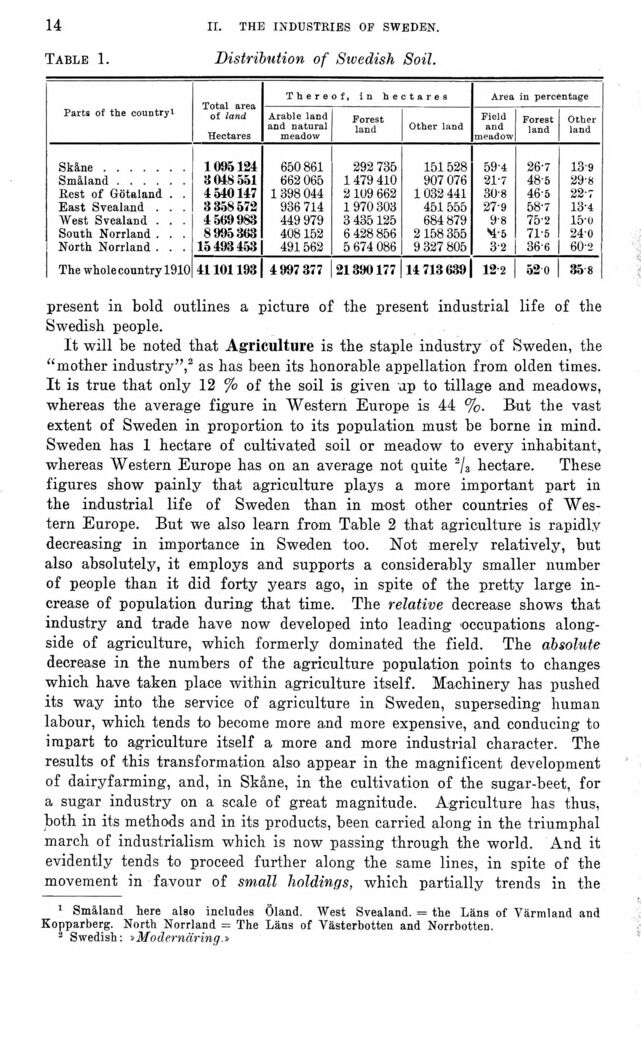
Full resolution (JPEG) - On this page / på denna sida - II. Industries of Sweden. General Survey. By P. Fahlbeck

<< prev. page << föreg. sida << >> nästa sida >> next page >>
Below is the raw OCR text
from the above scanned image.
Do you see an error? Proofread the page now!
Här nedan syns maskintolkade texten från faksimilbilden ovan.
Ser du något fel? Korrekturläs sidan nu!
This page has never been proofread. / Denna sida har aldrig korrekturlästs.
14 II. THE INDUSTRIES OF SWEDEN.
Table 1. Distribution of Sivedish Soil.
Parts of the country! Total area of land Hectares There of, in hectares Area in percentage
Arable land and natural meadow Forest land Other land Field and meadow Forest land Other land
Skåne ....... 1095124 650861 292 735 151528 594 26-7 13-9
Småland...... 3048551 662 065 1479 410 907 076 21-7 48-5 29-8
Rest of Götaland . . 4540147 1 398 044 2 109 662 1 032 441 30-8 46-5 22-7
East Svealand . . . 3 358572 936 714 1 970 303 451 555 27-9 58-7 13-4
AVest Svealund . . . 4569983 449 979 3 435 125 684 879 9-8 75-2 15-0
South Norrland . . . 8995363 408152 6 428 856 2 158 355 M-5 71-5 240
North Norrland . . . 15 493 453 491562 5 674 086 9 327 805 3-2 366 60-2
The whole country 1910 41101193 4 997 377 21390177 14 713 639 122 520 35 8
present in bold outlines a picture of the present industrial life of the
Swedish people.
It will be noted that Agriculture is the staple industry of Sweden, the
"mother industry",2 as has been its honorable appellation from olden times.
It is true that only 12 % of the soil is given up to tillage and meadows,
whereas the average figure in Western Europe is 44 %. But the vast
extent of Sweden in proportion to its population must be borne in mind.
Sweden has 1 hectare of cultivated soil or meadow to every inhabitant,
whereas Western Europe has on an average not quite 2/3 hectare. These
figures show painly that agriculture plays a more important part in
the industrial life of Sweden than in most other countries of
Western Europe. But we also learn from Table 2 that agriculture is rapidly
decreasing in importance in Sweden too. Not merely relatively, but
also absolutely, it employs and supports a considerably smaller number
of people than it did forty years ago, in spite of the pretty large
increase of population during that time. The relative decrease shows that
industry and trade have now developed into leading occupations
alongside of agriculture, which formerly dominated the field. The absolute
decrease in the numbers of the agriculture population points to changes
which have taken place within agriculture itself. Machinery has pushed
its way into the service of agriculture in Sweden, superseding human
labour, which tends to become more and more expensive, and conducing to
impart to agriculture itself a more and more industrial character. The
results of this transformation also appear in the magnificent development
of dairyfarming, and, in Skåne, in the cultivation of the sugar-beet, for
a sugar industry on a scale of great magnitude. Agriculture has thus,
both in its methods and in its products, been carried along in the triumphal
march of industrialism which is now passing through the world. And it
evidently tends to proceed further along the same lines, in spite of the
movement in favour of small holdings, which partially trends in the
1 Småland here also includes Öland. West Svealand. = the Läns of Värmland and
Kopparberg. North Norrland = The Läns of Västerbotten and Norrbotten.
2 Swedish: >Modernäring.»
<< prev. page << föreg. sida << >> nästa sida >> next page >>